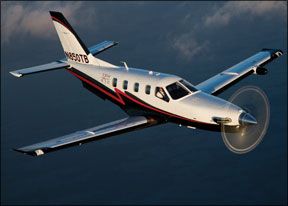All but obscured by the lava flow of VLJ hype is this simple reality: For more than a year, one of the most conservative and oldest airplane manufacturers in the world has been delivering a single-engine turboprop with the performance, legs and load-carrying ability to make any would-be VLJ buyer think twice. The EADS Socata TBM 850 whistles along at a max cruise of 320 knots at FL260, only 20 knots slower than most of the VLJs advertise. It goes further with a load of passengers and burns a lot less fuel. For the owner-pilot, the speed, operating costs and the allure of limiting insurance-mandated training to three days a year rather than nearly two weeks for the VLJ means that the 850 is a contender. We were surprised by the numbers, frankly. In a world that sells airplanes bare to keep the advertised price down, Socata is refreshingly realistic. It provides a basic price for the airplane at about $2.6 million and its literature promptly admits that virtually no airplanes are ordered with basic equipment. Based on sales history, Socata says an average equipped price for the TBM 850 is $2.8 million. That number includes all of the options, of which there arent many. The only big ticket option we saw was a pilots side door at $75,000.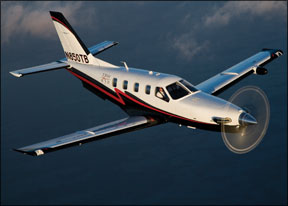
Background
Socata is a direct descendant of Morane-Saulnier, which began building high-performance monoplanes in 1911. Its now a wholly-owned subsidiary of EADS, one of the worlds largest aerospace manufacturers. Based in Tarbes, France, Socata in 1990 certified the TBM 700, an aerodynamically clean, six-place, pressurized turboprop powered by a 700-HP Pratt & Whitney PT-6. The airplane proved successful, with the majority selling in the U.S. For the 850, Socata upped the power to 850-HP with the PT6A-66D and made a few changes to correct perceived shortcomings of the TBM 700, including a lack of baggage space.
In the era of composite airplanes with glass cockpits, the TBM 850 is so conventional its almost retro. The basic airframe is aluminum with a double spar wing thats somewhat overbuilt, having been tested to plus 9 and minus 6 Gs. The horizontal and vertical stabilizers, control surfaces and fairings are composite. In order to keep the stall speed down, long-span Fowler flaps are used, creating a lack of room for ailerons. To get the desired roll control, spoilers are used, so roll rate is brisk and spoiler/aileron interface is seamless.
The combination of old-line structure and a few composites combine to produce a Vmo of 266 KIAS. By comparison, the Eclipse 500, a jet, publishes a Vmo only 19 knots higher: 285 KIAS.
The PT6A turns a four-blade full-feathering reversing Hartzell prop. TBO is currently 3000 hours, although we would expect that to increase with service experience. Dual-position bleeds allow normal operating bleed air to be pulled from the P2.5 position, rather than the P3 position, making for greater engine performance with lower fuel burn because less heat and power is extracted from the engine. Fuel totals 281 gallons usable in two wing tanks, each protected against impact by the wing spars.
No Glass
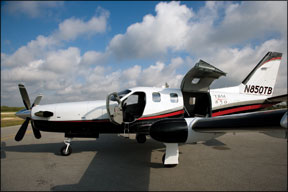
Instruments are in a conventional six pack with an EFIS ADI and HSI, rather than a glass panel. On an airplane with this performance, we were disappointed with that and also to find a yoke in an airplane with almost elegant handling. Given current advances, blocking the panel with a device that can also cause injury in a crash doesnt make much sense, in our view. Conservative design can be carried too far.
The most popular avionics package consists of dual Garmin GNS530s, EHS/EADI EFIS 40, Garmin GMX200 MFD, RDR 2000 radar, KMH 880 EGPWS and traffic system, WX-500 Stormscope, radar altimeter, RMI, DME, KFC 325 autopilot and two Bose X headsets. ADF is an option, as its required in some countries. We were told Socata is evaluating glass cockpits, but has made no decision on a provider. All of the airplanes are delivered RVSM compliant.
The cabin is 13.29 feet long and 3.97 feet wide with a freight area length of 10 feet. The seat tracks on either side of the cabin are continuous, which means the airplane will accommodate a pilot of any size. The long seat travel, combined with adjustable rudder pedals, make this one of the most comfortable cabin-class airplanes weve ever flown. The only shortcoming is for tall pilots; the seat cant be lowered enough to reach the ideal sight line. The pilot seats have four-point shoulder harnesses while passenger seats-club seating is standard-have three. Seat belt air bags are in the works.
The huge main cabin door hinges upward. It closes via a push button, so there’s no need to go through a-leap up-haul-down-and-slam exercise. Baggage space is
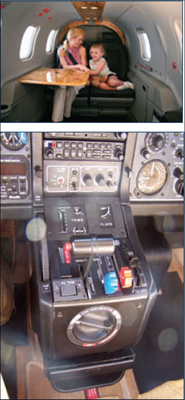
162
available inside the pressure vessel behind the aft seats and also outside the pressure vessel aft of the cabin and in the nose.
The TBM 850 is approved for flight into known icing using a hot prop, electrically heated windshields and boots. The boots are smoothly faired into the airfoils, avoiding the drag penalties of most installations. The wing boots are in three sections, each attached to a Kevlar leading-edge section. In what we felt is a useful design feature, the Kevlar leading edge can be removed quickly to allow access to systems located forward of the fuel tanks. We think that the strength of the Kevlar edge will also serve to increase crash protection for the fuel tanks.
The pressurization system provides a 6.2 PSI max differential, giving a 9300-foot cabin at the max operating altitude of FL310. During our demo flight, we had one brief pressure bump during a rapid power reduction at altitude, but otherwise the system operated seamlessly. The electrical system is powered by a 200-amp generator with a 70-amp backup and there’s redundancy for all systems other than the powerplant.
There have been no engine failure accidents in the TBM 850, although there has been one in-flight shutdown. An engine failure or shutdown at altitude means loss of pressurization and an emergency descent to 12,000 feet, at which point trimming to max range glide speed of 120 KIAS with the prop feathered will yield 27 miles of gliding distance.
Because the airplane could not meet certification requirements for the amount of acceptable roll off in a full power, landing configuration stall and because the TBM 700 could, the 850 has a torque limiter that works when the flaps are extended. This means that at any flap setting, 700 HP rather than 850 HP is available. The procedure is to depart with the power set to 100 percent torque, raise the gear at positive rate, then raise the flaps when obstacles are cleared. At 1500 feet AGL, the flap switch is moved to a position marked 850, which disables the torque limiter. The pilot brings the power up to 121.4 percent, unleashing all 850 horses, as the rate of climb scoots to about 2000 FPM.
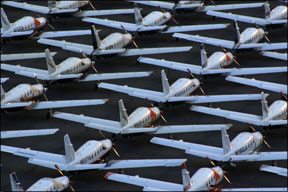
In our view, occupant crash protection is slightly below the level expected in an aircraft of this sophistication. There’s fuel in the pressure vessel-lines are routed from the wing tanks to the engine, something Piper was able to avoid in the Meridian. We don’t like the overhead panel switches because they can cause head injuries during impact, but we applaud the “crash lever” switch that allows the electrical system to be shut down in an emergency with a flick of one finger.
Big Hauler
When we calculated weight and balance for the TBM 850, were astonished to find that Socatas advertised typical empty weight was realistic. Socata touts 4698 pounds in sell copy and at 4680 pounds, the airplane we flew weighed less. With a zero-fuel weight of 6032 pounds, the 850 can carry 1334 pounds in the cabin and baggage areas. That means six 200-pounders and 134 pounds of baggage.
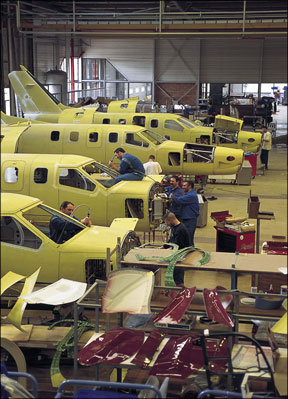
With a max ramp weight of 7430 pounds-max takeoff is 7394 pounds, max landing 7024 pounds-1398 pounds of fuel can be carried if the cabin is loaded to the zero fuel weight. With full fuel, the airplane is good for 806 pounds of payload. With that load and full tanks, the TBM has a maximum VFR range-with 45 minute reserve-of about 1365 miles at high cruise. At long-range cruise, range increases to 1520 miles. With the airplane loaded to the zero fuel weight, range is still about 1000 miles at high cruise and 1100 miles at long-range cruise.
When we worked various combinations of loading for balance, we found that it was easy to load the airplane within its CG range. With just front seat occupants, the airplane is at or near the forward limit. Otherwise, there’s no tendency for it to be out of CG with various passenger and baggage combinations.
Flying It
Flying the TBM 850 is a ball. To put it bluntly, it goes like hell and is easy to fly. It revealed no surprises or dark habits, which goes a long way to explaining the lack of problems with insuring an airplane this fast. During taxi, the exhaust stacks provide about 40 pounds of thrust, so the airplane will accelerate away from a stop, requiring reverse thrust while taxiing. Takeoff is with takeoff/approach flaps selected and the POH says a gross weight, standard-day sea-level ground run is 2035 feet, with 2840 feet to clear a 50-foot obstacle. Normal climb attitude results in the long nose blocking the view directly ahead.
Through 1500 feet AGL, when the flap switch is moved forward to the 850 mark and the power lever moved up, there’s need for rudder trim fine tuning to keep the ball centered and we noted just a slight pitch change with flap retraction or extension.
In maneuvering flight, with changing power and speed, control forces are comfortable and rapid response, especially in roll, combined with the variable rudder forces reminded us a little of the P-51 Mustang. With that big prop and all that power, this is very much a rudder airplane. Slow flight, both clean and in landing configuration, was solid, although at low power settings, it was difficult to accurately make small power changes. We couldnt tell whether there was some friction in the power lever control system or if the throttle is simply sensitive in the 20 to 40 percent torque range.
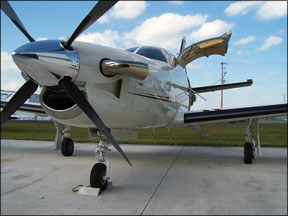
Stalling the airplane-clean or dirty-provoked a roll to the left, perhaps because of the radar pod on the leading edge of that wing. It was controllable, but we couldnt arrest the roll even with a centered ball. There were no surprises during the recovery.
On the climb to altitude, the TBM 850 maintained just under 2000 FPM all the way to about FL240, where torque must be reduced as the engine hits its temperature limits. Torque must be monitored during the climb; setting is not automatic.
In level flight, the nose is noticeably lower than it is on the ground, so visibility is good. We monitored speed at a few altitudes and found that they generally came within a percent or two of published data. At FL260, the best altitude for the airplane and ISA plus 12 degrees C, we calculated 308 knots at max cruise power. The fuel burn was 59.1 GPH. The book called for 312 knots at 63.6 GPH. We were told that POH speeds are without the radar pod and antennas, which seems silly, since every airplane is likely to have radar.
At long range cruise at FL260 (56 percent torque), the airplane delivered a speed of 228 knots at a fuel burn of 39 GPH. The POH advertised 231 knots and 39.7 GPH.
Descents are easy. Using various combinations of power and speed brakes, we had no trouble fitting in with ATC needs for a busy terminal area. The autopilot installation was especially smooth on leaving an altitude, holding a desired descent rate or indicated airspeed and on capturing an altitude. The avionics installation is intuitive and we anticipate it wont require much training for a new pilot, which makes it more likely that the pilot will be looking outside for traffic rather than inside trying to program the avionics.
One thing thats nice about a big turboprop is that its easy to change speed quickly in terminal airspace. Approach flaps can come out at 178 knots-also the max gear extension speed-and this gives a deck angle similar to cruise, allowing good visibility when its needed for a high traffic area.
We flew an ILS at 110 knots. Experimenting, we noted that even with the clean airframe, once the gear is down, its not difficult to fly fast enough to stay ahead of airline traffic and then rapidly slow at the runway. On short final at the 7024 pounds max landing weight, a sedate 85 knots makes for a published 2430-foot sea level landing distance over a 50-foot obstacle; 1840 feet of that is ground roll. We found that the use of reverse after touchdown reduced the landing roll significantly, but reverse cant be used in calculating landing distances.
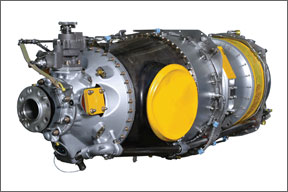
On landing, power is reduced to idle we’ll ahead of the flare and not much flare is required. Ground effect helps to pitch up the airplane slightly, as with many jets, but the relatively stiff oleo gear makes it challenging to make a greaser. Responsive controls-especially in roll-means there’s never any question of controllability in gusts or crosswinds. We would have no qualms about basing this airplane at an airport with as little as 3500 feet of obstacle-free runway for day and night operations.
Warranty, Training
The warranty provides seven years of coverage on the airframe, five years on avionics, five years on the engine and two years on the prop. New owners will pay only for consumables during the first two years of ownership, with the 100-, 300- and 600-hour and first annual inspections included in the warranty. Because the majority of the airplanes come to the U.S., Socata seems to be determined to provide good customer support, having set up a large parts department with 24-hour support at their U.S. base at North Perry Airport in Pembroke Pines, Florida. (Contact www.socata.com, 954-893-1415.)
If a part is not available in the U.S., FedEx ships from France. There are 13 service centers in the U.S., located where the customer airplanes are concentrated. Further support is provided via the TBM owners Website in which Socata customer service reps are active.
Training is being offered by Simcom at its Orlando, Florida, facility. Insurance requirements for owner pilots are currently 25 hours of dual initially and annual recurrent training. We know of no reports of pilots having difficulty insuring these airplanes, with annual premium cost at about 0.9 percent of hull value.
Conclusion
The TBM 850s performance rivals the current VLJs, although at a higher price. True, its slower, but it carries more and has more range, so on some legs, it will beat the VLJ door-to-door. Further, while a VLJ has to burn the fuel to climb nearly 10,000 feet higher to get its best speed, the TBM 850 is happy in the mid-20s. It will be interesting to see if ATC will dole out the higher flight levels to 340-knot light jets.
By our estimation, it should be cheaper to operate the TBM 850 than a VLJ. But at a purchase price of $2.8 million, will a lower hourly cost impress a potential owner that much? Maybe. We think the TBM 850 would have a better shot with a Garmin or Avidyne glass panel system. And, in the world of airplane marketing, hard facts often give way to emotion. A jet just has a cachet that a turboprop doesnt, despite the economics.
Bottom line: Socata has produced a conservatively designed airplane thats easy to fly and goes like blazes for an operating cost we’ll below anything else in the speed range. The airplane is capable with a proven track record and the company has been around since general aviation was a lieutenant, something none of the VLJ makers except Cessna can say and they insist they don’t have a VLJ anyway.
There’s not a lot new in the TBM 850, just common sense engineering, countersunk rivets in a clean airframe, a big engine and a lot of speed. And you can buy one right now. No waiting.
Rick Durden is an
Aviation Consumer contributing editor.
